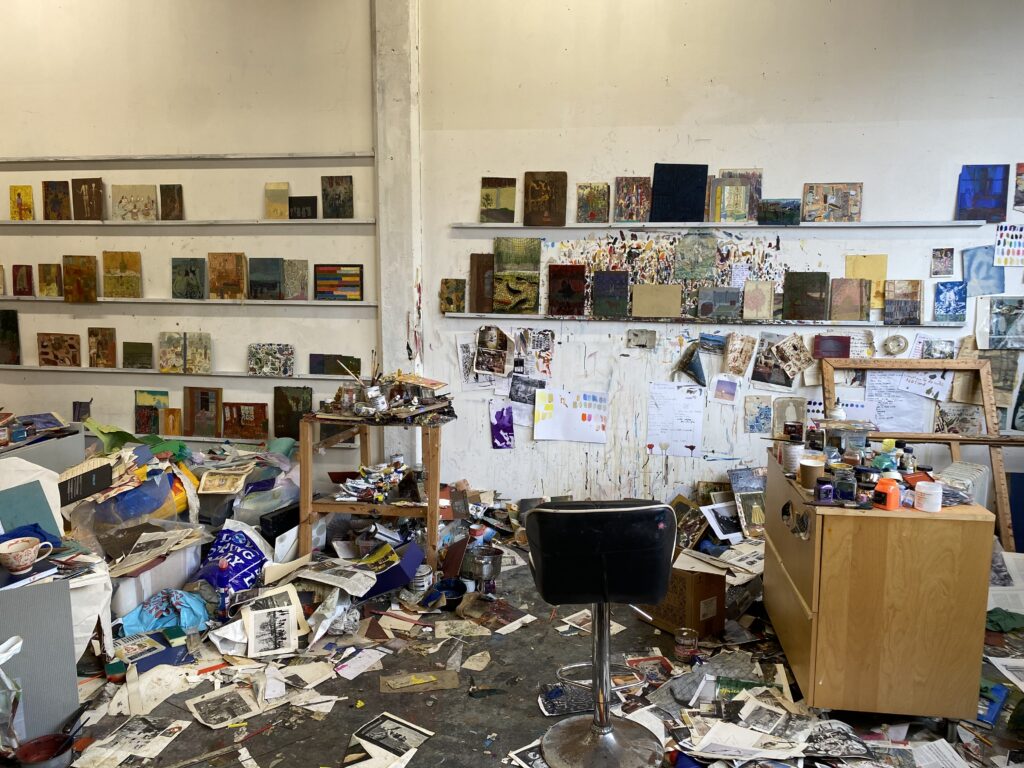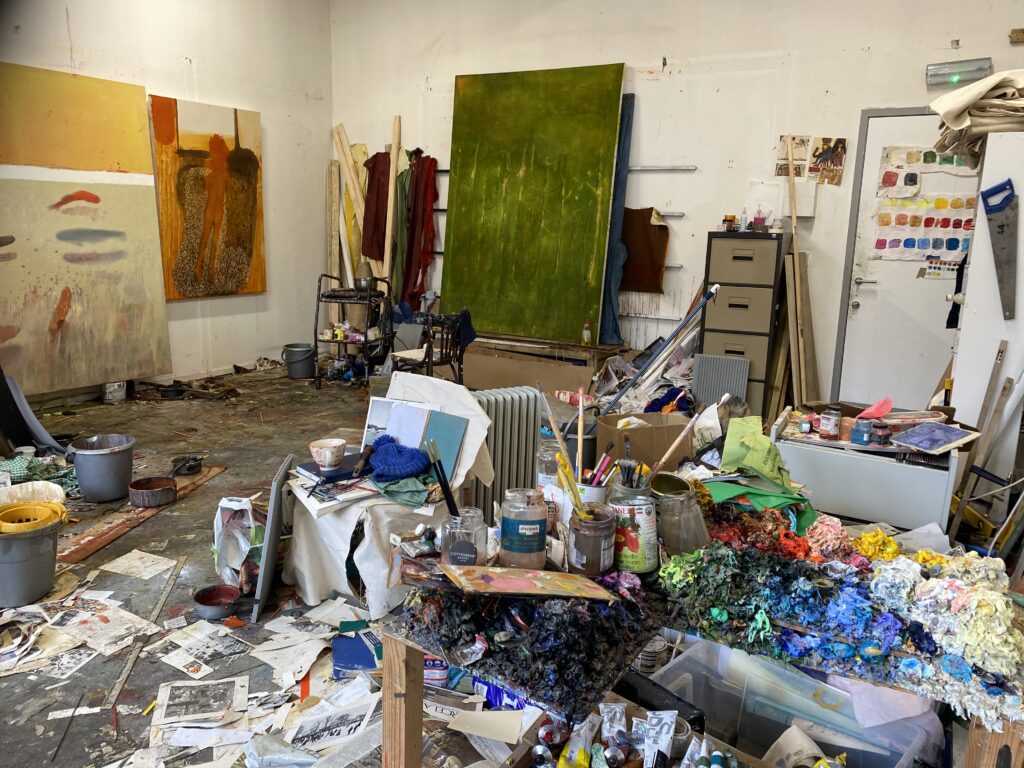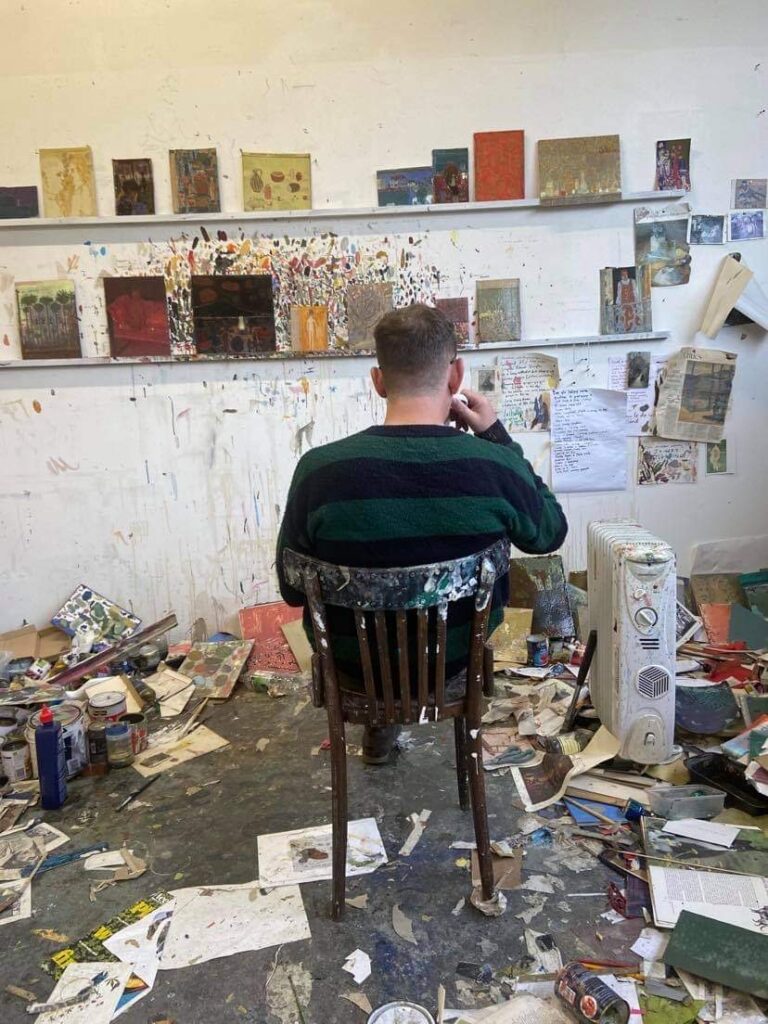Painting Backward: A Conversation with Andrew Cranston
Andrew Cranston, whose painting A Room That Echoes appears on the cover of the Review’s new Spring issue, did not intend to become a painter. He grew up in Hawick, a small industrial town in Scotland, and planned to become a joiner. For a time he was in a band, and he eventually started sketching. In 1996, he completed his M.A. in painting at the Royal College of Art in London. He now lives in Glasgow with his partner, Lorna Robertson, who is also an artist and works in the studio next to his. When I first saw Cranston’s show “Waiting for the Bell” at Karma Gallery last summer, I was delighted. His paintings, tinged with humor and a sense of longing, invite the viewer into what feels like another person’s dream. I called Cranston from New York while he was in Scotland, preparing for his next show in London. We planned to briefly discuss his work, but ended up speaking for two hours about books, golf, and monkeys.
INTERVIEWER
How did you start to paint on book surfaces?
CRANSTON
I ran out of things to paint on, and I found some books in the studio, so I started working on them. They instantly seemed full of potential—they linked the work to a kind of narrative storytelling and literary interest quite explicitly. And a book, as opposed to a blank canvas or piece of paper, has a particular color and shape, a particular size. You’re destroying the book in some way but making something else with it.
INTERVIEWER
There’s a fictional or poetic quality to your paintings. Do you reference real-life subjects, or are they imaginary?
CRANSTON
A lot of it is rooted in experience. One of the paintings in the show depicts a kind of wall by a beach. That came out of looking at this one tiny corner of a Christopher Wood painting, particularly a wall in the painting. It triggered a memory of being on holiday in Cornwall, which was where Wood lived, and that opened up into trying to remember that holiday, and even trying to remember photographs of that holiday, which I hadn’t seen for a long, long time. So, the art is based on experience, but so many other things get woven in—other paintings, scenes from films, and real places that are there in front of you, but also places remembered.
INTERVIEWER
I’ve seen dogs, monkeys, turtles in your paintings. Do you have any pets?
CRANSTON
Not at all. My dad had, in his childhood, lots of pets, including dogs and cats and birds—and a monkey his granddad ended up with. This was in the twenties or thirties in Scotland. We used to get told about this monkey quite a lot. A funny thing happened when my dad was quite old and quite close to death in a nursing home, and a woman who must have been in her nineties was brought in to see him. She suddenly sparked alive and said, “I remember you. I remember your monkey.” My brother told me it was a hair-standing-on-end moment, because we’d heard about this monkey but never seen any photographs or anything of it. Was it really real, this monkey? And suddenly this person remembered it.
There’s something just strange about animal presences, I think, around you. I don’t have any pets. A way for me to have pets is to put them in paintings.
INTERVIEWER
Do you work on multiple paintings at once?
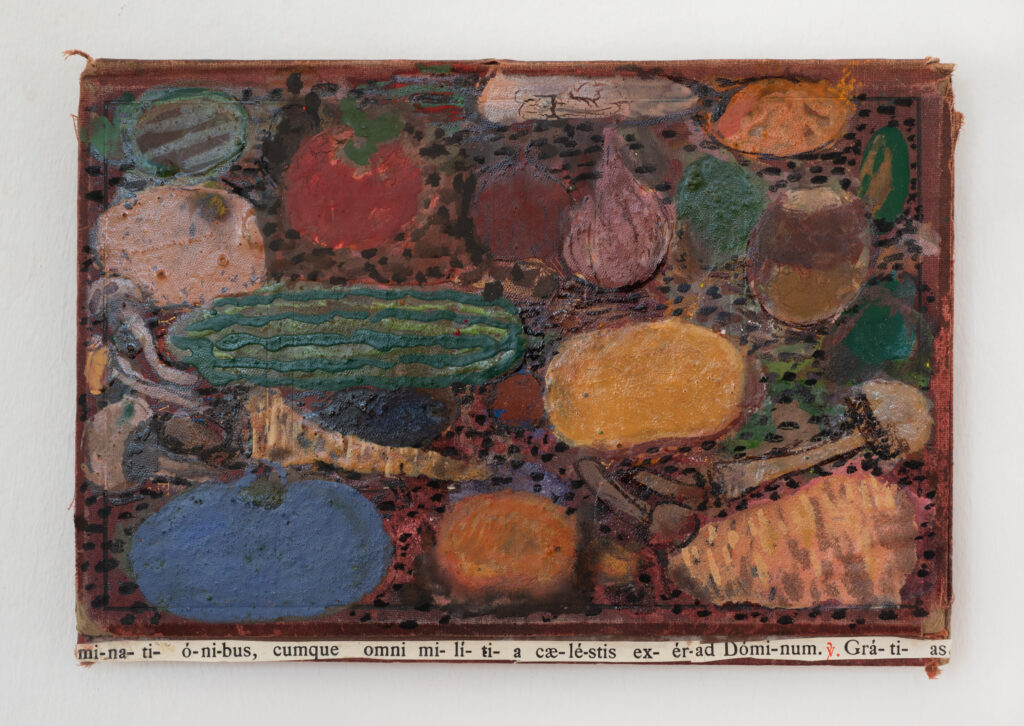
Winter Vegetables (To Robert Bell Cranston). Courtesy of the artist and the Ingleby Gallery, Edinburgh.
CRANSTON
Yes. I will have literally fifty, at least, small paintings in progress at one time. I can’t ever really decide how to finish paintings, so I’ve got the same disease as Cézanne. The only way I can kind of make it work is if I just start another.
INTERVIEWER
How do you know when a painting is done?
CRANSTON
I think it’s quite like bomb-disposal work, finishing a painting. You can do too much and spell things out too much. I don’t really like when every t is crossed and every i is dotted. I want something that’s still open-ended. Sometimes you have to paint backward, when you go past the point at which you had something that was quite mysterious and slightly ambiguous—you realize you’ve made it too clear and too obvious, and then there’s some undoing of that.
A few years ago, I did a painting that was explicitly about writing—it was a bit like the work I did for the Paris Review cover. I write as well, and I was interested in the aspect of writing that is very interior. Most writers do write in rooms—I know that Hemingway wrote in cafes, but probably most do shut themselves away—so, I was working with that idea. That painting sat for a year. I was really looking to do something else to it, and then I realized it was finished. There was nothing else to do.
INTERVIEWER
Tell me about the goldfish in A Room That Echoes.
CRANSTON
You can’t really paint goldfish without bringing up Matisse. Matisse owns goldfish, really. He kind of owns red, as well. It’s very hard to think of red paintings without Matisse.
INTERVIEWER
He owns the color red and goldfish.
CRANSTON
You know, Van Gogh has yellow. Matisse has red. Picasso has blue. But the goldfish, I think, poses an interesting problem for a painter—how to represent things like water and glass. The fish was the ping of color that I felt the painting needed. In an abstract sense, I needed something to puncture that kind of atmosphere, the whole fog of the green. That thing became the goldfish.
INTERVIEWER
Do you paint every day?
CRANSTON
Most days. When the pandemic first was unfolding, we were very much in our routine of doing some homeschooling with Joseph, who’s now thirteen, until maybe two o’clock. Then we’d both walk to the studio. We would get to the studio at two thirty, and then we’d work until eleven, then eat, and then do the same thing all over again. That was a very interesting time, in a way, because of the space we went into in each day. I remember reading As I Lay Dying and being especially struck by the fact that—maybe this was in the introduction—Faulkner wrote that book in a six-week period when he was working a job, and the job was a night shift. He would finish at a certain point, midnight or something, and then go home and write from midnight till four or five in the morning, and then get up the next day. The book came out of that process and that space that you can find in a day.
INTERVIEWER
When you’re doing other things, are you still thinking about painting?
CRANSTON
Yes. It’s a total curse. I had a tutor who used to say, in a mantra-like way, “Whatever situation you’re in, ask yourself, ‘Is there a painting in this?’” I’ve really digested that advice. I’ll be in a nightclub and still be thinking, Should I make this nightclub scene into a painting? People sometimes fetishize ideas, but often an idea comes out of just paying attention to a situation. Some part of me is always on the lookout for material I could use. One of the great subjects in painting is people sitting around—bathers, or just people sitting on the grass.
INTERVIEWER
Are there specific authors or works you revisit? Does your reading ever influence your work?
CRANSTON
Books are a huge influence. I’m more a reader of poetry and of short stories than of novels. Winesburg, Ohio by Sherwood Anderson, James Joyce’s Dubliners, things like that—little glimpses into things. I get a lot from the poet W. S. Graham, who was a Scottish poet based in Cornwall for most of his life. He wrote quite a few poems about painting, and he had a real interest in vision. I like D. H. Lawrence’s poems as well, and Seamus Heaney’s. I like how you can read a poem or a short story quite quickly, but digest it very slowly so that the aftereffects are lasting.
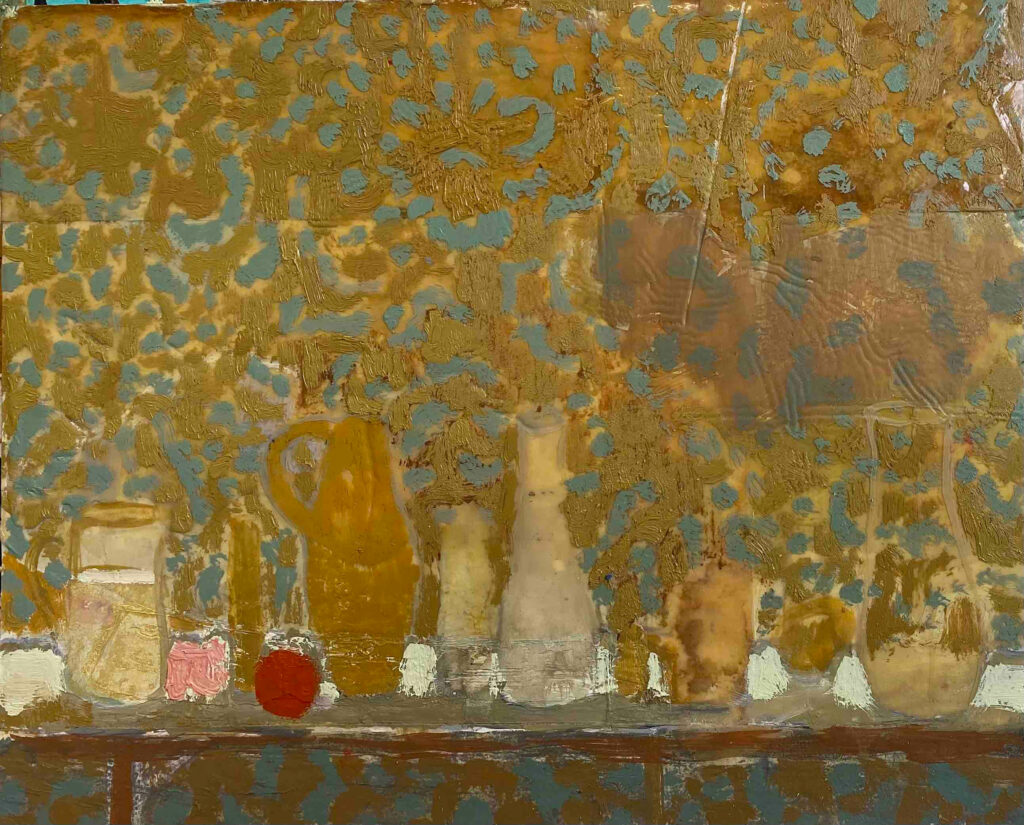
The Hue of an Orange, oil and varnish on hardback book cover, 2021. Courtesy of the artist and Ingleby Gallery, Edinburgh.
INTERVIEWER
Is there a particular color that you end up using more than others? Do you have a favorite color that you find yourself sneaking into paintings?
CRANSTON
Yellow. A lot of the paintings start yellow. When I was growing up, a friend of my dad’s from Manchester used to come and visit us. One time he brought us packs of paper he said had fallen off the back of a lorry. There was so much of this paper that we never needed any more paper for the whole rest of our childhood—there was always paper to draw on and make comics. Most of it was yellow, a very pale, quite cold yellow, and most of the drawings I made when I was young were on this yellow paper. Whether that’s the reason, I don’t know. Yellow’s an interesting color psychologically as well. It can feel a bit sick and a bit ill sometimes, jaundiced or something. It’s the color that is the most mysterious to me.
INTERVIEWER
How many brushes do you have?
CRANSTON
A lot, but quite often I’ll make a painting with just one brush. The painter Steven Campbell once gave me the critique, “You’ve only got one brush.” But I find if you use one brush, you are, in effect, putting some of the color all over the painting. It’s a way of connecting bits of the painting. And using a terrible brush can force you to work in ways that make a more interesting painting. I sometimes look at a Rembrandt and see how he’s done the hair, and it looks like he’s used the scruffiest old hardened brush, not his best brush. So I’ve got certain brushes that I use all the time, but they’re not good brushes. You have to invent and to adjust to the tool, and it gives you something quite unexpected.
INTERVIEWER
What do you do for fun besides painting?
CRANSTON
I play a bit of golf. I think golf’s quite different in other countries, but it’s still quite a working-class sport in Scotland and cuts across a lot of class structures. It’s quite cheap, and it’s very easy to get clubs at secondhand shops and thrift shops. I know Mark Twain said golf was a walk spoiled, but you are dealing with some construct of nature when you golf. Some of the Scottish courses are very wild. They’ve not really been tamed or cultivated in the way that other courses in America have been. They tend to use the natural aspects of whatever the landscape’s got: dunes along the coast or the woods. It’s kind of like land art. Golf is land art on a large scale.
INTERVIEWER
Can we expect some golfing to show up in your future paintings?
CRANSTON
Well, it’s so uncool, golf. It does appeal to me in that sense. It’s almost a taboo subject because it’s so uncool. I’ve read that Samuel Beckett was a really big golfer, and I can see that there are slightly surreal qualities about golf. You’re trying to get this ball in a tiny hole, and it’s quite frustrating. There’s something cartoon-like about it. I did do some golf paintings when I was younger. I might do it. I might make another golf painting.
INTERVIEWER
How do you come up with the titles for your paintings? There’s one that I love, and I love the painting: It Was Your Birthday (And a Seagull Shat on Your Head).
CRANSTON
That happened to my partner, Lorna, on her birthday, so that is based on a real experience. I store up the titles. I have them all written down, and sometimes they happily match an idea or match an image. I write on the work as well. I write notes on the paintings, just loose notes about how the painting could go or what it could be about or things it reminds me of. They’re like little index cards or reminders to myself. It’s so fleeting, sometimes, a painting. You forget what you’re meant to be doing. The painting seems to vanish before your eyes. It’s like Orpheus—when he looks for his lover, she disappears.
INTERVIEWER
When Orpheus turns around.
CRANSTON
Yeah. It’s a bit like that.
INTERVIEWER
That’s a great metaphor for painting.
CRANSTON
It’s always slightly out of reach.
Na Kim is the art director of The Paris Review.
Copyright
© The Paris Review


